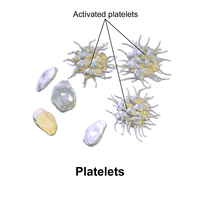
Photo from wikipedia
Background Thrombocytosis can be classified as primary or secondary, also called reactive. If primary thrombocytosis is a very rare condition in children, reactive thrombocytosis occurs commonly in children and it… Click to show full abstract
Background Thrombocytosis can be classified as primary or secondary, also called reactive. If primary thrombocytosis is a very rare condition in children, reactive thrombocytosis occurs commonly in children and it is associated, especially with infections, anaemia and many other causes. Aim of the study is to identify the aetiology, incidence and clinical significance of thrombocytosis in children admitted to a Tertiary Paediatric Clinic. Material and method We analysed retrospectively data from children admitted in the Paediatric Clinic of ‘Filantropia’ Hospital of Craiova over a period of three months for presence of thrombocytosis (platelet>400×109/L). Results From a total of 426 cases we found 21 who associated reactive thrombocytosis, 90.46% being correlated with lower respiratory tract infections. 14.29% of cases had acute enterocolitis. One case associated both respiratory and digestive symptoms. The most common infection was acute bronchiolitis (52.38%) followed by acute interstitial pneumonia (23,80%). In 66.6% of cases lymphocytosis was noted. Infection and anaemia (57.14%) was a frequent association. One case had minor β-thalassemia. 95.23% of patients presented mild thrombocytosis and only one case had moderate values (>700×109/L). Routine prophylactic antiplatelet treatment was not neccesary in our cases. Conclusions Reactive thrombocytosis is a common finding in hospitalised children, associated especially with viral lower respiratory tract infection. Infections with anaemia was a frequent finding correlated with reactive thrombocytosis.
Journal Title: Archives of Disease in Childhood
Year Published: 2017
Link to full text (if available)
Share on Social Media: Sign Up to like & get
recommendations!